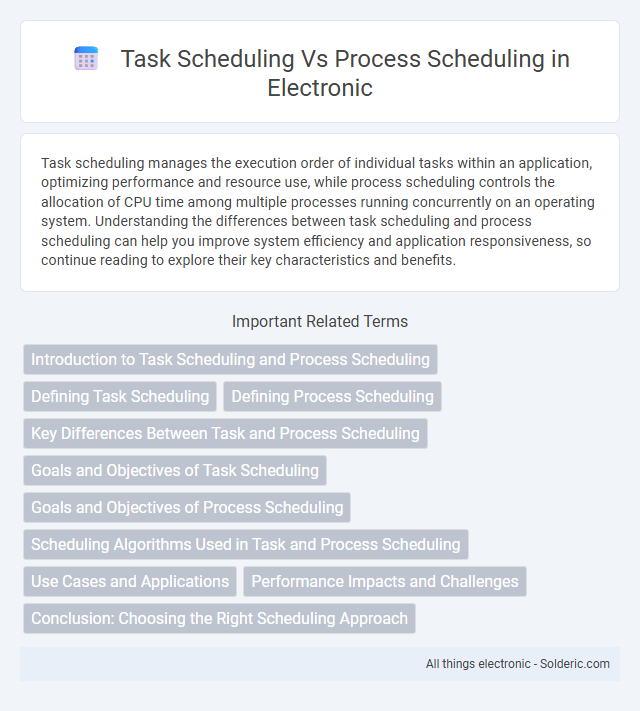Task scheduling manages the execution order of individual tasks within an application, optimizing performance and resource use, while process scheduling controls the allocation of CPU time among multiple processes running concurrently on an operating system. Understanding the differences between task scheduling and process scheduling can help you improve system efficiency and application responsiveness, so continue reading to explore their key characteristics and benefits.
Comparison Table
| Aspect | Task Scheduling | Process Scheduling |
|---|---|---|
| Definition | Allocates tasks or jobs to system resources for execution. | Manages execution of processes within an operating system. |
| Scope | Broader, includes batch jobs, workflows, and automation tasks. | Specific to CPU time allocation among active processes. |
| Primary Focus | Task prioritization, timing, and resource assignment. | Process state management and CPU time slicing. |
| Operating Context | Used in distributed systems, job scheduling systems, and automation. | Core component of operating system kernel scheduling. |
| Scheduling Criteria | Depends on task deadlines, priorities, dependencies. | Based on process priority, CPU burst time, and fairness. |
| Examples | Cron jobs, workflow managers, batch schedulers. | Round Robin, Multilevel Queue, Shortest Job First scheduling. |
| Resource Managed | System resources including CPU, I/O, memory for task completion. | Primarily CPU scheduling with context switching. |
| Time Granularity | Can be coarse (minutes, hours) to fine (milliseconds) based on task. | Fine granularity, on the order of milliseconds or microseconds. |
Introduction to Task Scheduling and Process Scheduling
Task scheduling manages the allocation and execution order of tasks within a system, optimizing resource use and meeting deadlines. Process scheduling, a subset of task scheduling, focuses specifically on managing processes in operating systems, handling CPU allocation to ensure efficient multitasking and system responsiveness. Your understanding of these concepts can enhance system performance and application responsiveness.
Defining Task Scheduling
Task scheduling involves organizing and assigning individual tasks within a system to optimize resource use and meet deadlines, focusing on task-level granularity. Unlike process scheduling, which manages processes consisting of multiple tasks or threads, task scheduling is crucial in real-time and embedded systems where precise timing and prioritization of discrete tasks are essential. Effective task scheduling improves system responsiveness and ensures timely task completion by prioritizing tasks based on constraints and dependencies.
Defining Process Scheduling
Process scheduling is the method by which an operating system allocates CPU time to various active processes, ensuring efficient execution and system responsiveness. It involves managing process states, prioritizing tasks, and coordinating CPU time slices to optimize overall performance. Your system's multitasking capabilities depend heavily on effective process scheduling algorithms, such as round-robin or priority-based scheduling.
Key Differences Between Task and Process Scheduling
Task scheduling manages individual units of work within an application, focusing on optimizing execution sequence to improve responsiveness and resource utilization. Process scheduling involves allocating CPU time to entire programs or processes, ensuring fair distribution of system resources and maintaining system stability. Understanding these distinctions helps you optimize performance by selecting the right scheduling approach for your system's needs.
Goals and Objectives of Task Scheduling
Task scheduling aims to optimize resource allocation, maximize throughput, and minimize latency by efficiently managing the execution order of individual tasks in real-time or embedded systems. It focuses on meeting specific deadlines and prioritizing tasks based on criteria such as urgency, importance, or periodicity to ensure time-critical operations are completed reliably. Effective task scheduling enhances system responsiveness and predictability, supporting real-time constraints and overall system performance.
Goals and Objectives of Process Scheduling
Process scheduling aims to maximize CPU utilization and ensure fair allocation of processor time among competing processes, improving system responsiveness and overall throughput. It focuses on minimizing waiting time, turnaround time, and response time while maintaining process priority and preventing starvation. Task scheduling, in contrast, often deals with organizing and executing specific tasks or jobs based on dependencies and deadlines rather than optimizing CPU resource distribution.
Scheduling Algorithms Used in Task and Process Scheduling
Task scheduling primarily uses algorithms like Round Robin, Priority Scheduling, and Earliest Deadline First to efficiently allocate time to tasks in real-time systems. Process scheduling in operating systems often relies on algorithms such as First-Come, First-Served (FCFS), Shortest Job Next (SJN), and Multilevel Queue Scheduling to manage CPU allocation among multiple processes. Understanding the appropriate scheduling algorithm helps you optimize system performance and resource utilization based on specific workload requirements.
Use Cases and Applications
Task scheduling is ideal for managing repetitive, time-sensitive jobs in environments like batch processing, automated backups, and IoT device operations where predefined task execution is crucial. Process scheduling, by contrast, is integral to operating systems, ensuring efficient CPU time allocation among active processes in multi-user or multitasking systems, enhancing responsiveness and resource utilization. Understanding these differences helps you optimize system performance by applying task scheduling for predetermined workflows and process scheduling for dynamic, concurrent program execution.
Performance Impacts and Challenges
Task scheduling optimizes lightweight operations by managing individual units of work, resulting in lower latency and improved responsiveness for your applications, especially in real-time environments. Process scheduling involves managing heavyweight processes, which can lead to higher overhead and context-switching costs, impacting system throughput and efficiency. Balancing the performance impacts and challenges of resource contention and priority inversion is critical for maximizing system performance and stability.
Conclusion: Choosing the Right Scheduling Approach
Selecting the right scheduling approach depends on the specific requirements of your system, whether optimizing task-level efficiency or managing complex process interactions. Task scheduling is ideal for real-time applications demanding precise timing, while process scheduling excels in multitasking environments prioritizing resource allocation and fairness. Understanding these distinctions ensures your system achieves optimal performance and responsiveness.
task scheduling vs process scheduling Infographic

 solderic.com
solderic.com